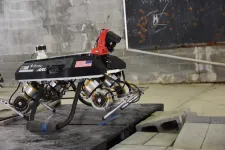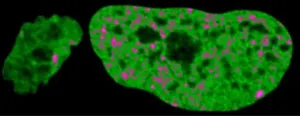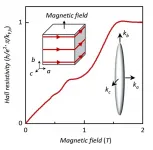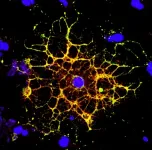The powerhouse future is flexoelectric
'Giant flexoelectricity' breakthrough in soft elastomers paves way for improved robots and self-powered pacemakers
2021-06-02
(Press-News.org) Researchers have demonstrated "giant flexoelectricity" in soft elastomers that could improve robot movement range and make self-powered pacemakers a real possibility. In a paper published this month in the Proceedings of the National Academy of Sciences, scientists from the University of Houston and Air Force Research Laboratory explain how to engineer ostensibly ordinary substances like silicone rubber into an electric powerhouse.
What do the following have in common: a self-powered implanted medical device, a soft human-like robot and how we hear sound? The answer as to why these two disparate technologies and biological phenomena are similar lies in how the materials they are made of can significantly change in size and shape - or deform - like a rubber band, when an electrical signal is sent.
Some materials in nature can perform this function, acting as an energy converter that deforms when an electrical signal is sent through or supplies electricity when manipulated. This is called piezoelectricity and is useful in creating sensors and laser electronics, among several other end uses. However, these naturally occurring materials are rare and consist of stiff crystalline structures that are often toxic, three distinct drawbacks for human applications.
Man-made polymers offer steps toward alleviating these pain points by eliminating material scarcity and creating soft polymers capable of bending and stretching, known as soft elastomers, but previously those soft elastomers lacked significant piezoelectric attributes.
In a paper published this month in the Proceedings of the National Academy of Sciences, Kosar Mozaffari, graduate student at the Cullen College of Engineering at the University of Houston; Pradeep Sharma, M.D. Anderson Chair Professor & Department Chair of Mechanical Engineering at the University of Houston and Matthew Grasinger, LUCI Postdoctoral Fellow at the Air Force Research Laboratory, offer a solution.
"This theory engineers a connection between electricity and mechanical motion in soft rubber-like materials," said Sharma. "While some polymers are weakly piezoelectric, there are no really soft rubber like materials that are piezoelectric."
The term for these multifunctional soft elastomers with increased capability is "giant flexoelectricity." In other words, these scientists demonstrate how to boost flexoelectric performance in soft materials.
"Flexoelectricity in most soft rubber materials is quite weak," said Mozaffari, "but by rearranging the chains in unit cells on a molecular level, our theory shows that soft elastomers can attain a greater flexoelectricity of nearly 10 times the conventional amount."
The potential uses are profound. Human-like robots made with soft-elastomers that contain increased flexoelectric properties would be capable of a greater range of motion to perform physical tasks. Pacemakers implanted in human hearts and utilizing lithium batteries could instead be self-powered as natural movement generates electrical power.
The mechanics of soft elastomers generating and being manipulated by electrical signals replicates a similar function observed in human ears. Sounds hit the ear drum that then vibrates and send electrical signals to the brain, which interprets them. In this case, movement can manipulate soft elastomers and generate electricity to power a device on its own. This process of self-generating power by movement appears as a step up from a typical battery.
The advantages of this new theory stretch beyond just that. In the process of research, the capability to design a unit cell that is stretch invariant - or remains unchanged under unwanted stretch transformation - emerged.
"For some applications we require certain amounts of electricity to be generated regardless of the stretch deformation, whereas with other applications we desire as much electricity generation as possible, and we have designed for both of these cases." said Mozaffari.
"In our research, we discovered a method to make one unit cell stretch invariant. The tunable nature of the flexoelectric direction can be useful for producing soft robots and soft sensors."
In other words, the amount of electric power generated from various physical stimulation can be controlled so that devices perform directed actions. This can moderate the functioning of electronic devices that are self-sufficient.
Next steps include testing this theory in a lab using potential applications. Additionally, efforts to improve on the flexoelectric effect in soft elastomers will be the focus of further study.
INFORMATION:
[Attachments] See images for this press release:

ELSE PRESS RELEASES FROM THIS DATE:
2021-06-02
SMU Office of Research & Tech Transfer - Whether they are in the technology or oil sector, selling shoes or healthcare products, for many companies, green is the new black. While maximising profit might have been the sole priority for most businesses a decade ago, these days it is common for mission-oriented companies to pursue the 'triple bottom line' of people, planet and profit, particularly through corporate social responsibility (CSR) efforts.
While such efforts are commendable, some investors remain primarily concerned about whether firms can do well by doing good; in other words, whether CSR actually can increase a company's value. For instance, CSR activities could enhance brand image and improve customer loyalty, or even make it easier to attract and retain talent, leading to ...
2021-06-02
ABERDEEN PROVING GROUND, Md. - A new formula from Army scientists is leading to new insights on how to build an energy-efficient legged teammate for dismounted warfighters.
In a recent peer-reviewed PLOS One paper, the U.S. Army Combat Capabilities Development Command, known as DEVCOM, Army Research Laboratory's Drs. Alexander Kott, Sean Gart and Jason Pusey offer new insights on building autonomous military robotic legged platforms to operate as efficiently as any other ground mobile systems.
Its use could lead to potentially important changes to Army vehicle development. Scientists said they may not know exactly why legged, wheeled and tracked ...
2021-06-02
BROOKLYN, New York, Wednesday, June 2, 2021 - Perovskite solar cells have progressed in recent years with rapid increases in power conversion efficiency (from 3% in 2006 to 25.5% today), making them more competitive with silicon-based photovoltaic cells. However, a number of challenges remain before they can become a competitive commercial technology.
Now a team at the END ...
2021-06-02
The organization of the human genome relies on physics of different states of matter - such as liquid and solid - a team of scientists has discovered. The findings, which reveal how the physical nature of the genome changes as cells transform to serve specific functions, point to new ways to potentially better understand disease and to create improved therapies for cancer and genetic disorders.
The genome is the library of genetic information essential for life. Each cell contains the entire library, yet it uses only part of this information. Special types of cells, such ...
2021-06-02
SMU Office of Research & Tech Transfer - Short selling often gets a bad rap because it is a type of trade that bets against the success of a firm. In essence, short selling allows investors to borrow stock from a broker to sell into the market with the hope of buying the stock back at a cheaper price, thus, profiting on the difference between the sell and buy prices. Because of this practice, short selling is sometimes seen as a controversial tactic.
Furthermore, speculative short selling attacks are concerning as it can put downward pressure on ...
2021-06-02
The quantum Hall effect traditionally only plays a role in two-dimensional electron systems. Recently, however, a three-dimensional version of the quantum Hall effect was described in the Dirac semimetal ZrTe5. It has been suggested that this version results from a magnetic field-induced Fermi surface instability that transforms the original three-dimensional electron system into a stack of two-dimensional electron systems. Now scientists at the Max Planck Institute for Chemical Physics of Solids in Dresden, at the Technical University of Dresden, at the Brookhaven National Laboratory in New York, at the Helmholtz Center Dresden-Rossendorf, the Max Planck Institute ...
2021-06-02
Boulder, Colo., USA: GSA's dynamic online journal, Geosphere, posts articles online regularly. Locations and topics studied this month include the Moine thrust zone in northwestern Scotland; the Eastern California shear zone; implementation of "OpenTopography"; the finite evolution of "mole tracks"; the southern central Andes; the work of International Ocean Discovery Program (IODP) Expedition 351; and the Fairweather fault, Alaska, USA. You can find these articles at https://geosphere.geoscienceworld.org/content/early/recent.
Detrital-zircon analyses, provenance, and ...
2021-06-02
RIVERSIDE, Calif. -- As its name suggests, dark matter -- material which makes up about 85% of the mass in the universe -- emits no light, eluding easy detection. Its properties, too, remain fairly obscure.
Now, a theoretical particle physicist at the University of California, Riverside, and colleagues have published a research paper in the Journal of High Energy Physics that shows how theories positing the existence a new type of force could help explain dark matter's properties.
"We live in an ocean of dark matter, yet we know very little about what it could be," said Flip Tanedo, an assistant professor of physics and astronomy and the paper's senior author. "It is one of the most vexing known unknowns in nature. ...
2021-06-02
It's long been known that people living with HIV experience a loss of white matter in their brains. As opposed to "gray matter," which is composed of the cell bodies of neurons, white matter is made up of a fatty substance called myelin that coats neurons, offering protection and helping them transmit signals quickly and efficiently. A reduction in white matter is associated with motor and cognitive impairment.
Earlier work by a team from the University of Pennsylvania and Children's Hospital of Philadelphia (CHOP) found that antiretroviral therapy (ART)--the lifesaving suite ...
2021-06-02
There is a long-held belief that having your pet sleep on the bed is a bad idea. Aside from taking up space, noisy scratching, or triggering allergies, the most common assertion averred that your furry companion would disrupt your sleep.
A new study published in the journal Sleep Health tells a different story. Researchers at Concordia's Pediatric Public Health Psychology Lab (PPHP) found that the sleep quality of the surprisingly high number of children who share a bed with their pets is indistinguishable from those who sleep alone.
"Sleeping with your pet does not appear to be disruptive," ...
LAST 30 PRESS RELEASES:
[Press-News.org] The powerhouse future is flexoelectric
'Giant flexoelectricity' breakthrough in soft elastomers paves way for improved robots and self-powered pacemakers








